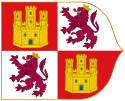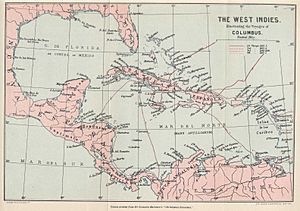Columbian Viceroyalty facts for kids
Quick facts for kids
Columbian Viceroyalty
Virreinato colombino
|
|||||||||||
|---|---|---|---|---|---|---|---|---|---|---|---|
| 1492–1535 | |||||||||||
|
|
|||||||||||
 |
|||||||||||
| Status | Colony of the Spanish Empire | ||||||||||
| Capital | Santo Domingo | ||||||||||
| Common languages | Spanish | ||||||||||
| Demonym(s) | Columbian | ||||||||||
| Government | Monarchy | ||||||||||
| King | |||||||||||
|
• 1493–1516
|
Ferdinand II and Isabella I (first) |
||||||||||
|
• 1516-1535
|
Charles I (last) | ||||||||||
| Viceroy | |||||||||||
|
• 1493–1500
|
Christopher Columbus | ||||||||||
|
• 1526–1535
|
Diego Columbus de facto | ||||||||||
| History | |||||||||||
|
• Human settlement
|
Before 1493 | ||||||||||
| 1492 | |||||||||||
|
• European settlement
|
1492 | ||||||||||
|
• Creation of the Viceroyalty of New Spain
|
1535 | ||||||||||
| Currency | Santo Domingo real | ||||||||||
|
|||||||||||
| Today part of | Dominican Republic Haiti |
||||||||||
The Columbian Viceroyalty was a special arrangement made for Christopher Columbus. It gave him important titles and rights over the lands he discovered. This agreement was made by the Spanish rulers, known as the Catholic Monarchs, in 1492. It happened just before Columbus began his first journey to the Americas. This arrangement was a big part of how the Americas began to be colonized by Europeans.
Contents
How the Viceroyalty Started
The special titles and powers given to Christopher Columbus were written down in an agreement. This agreement was called the Capitulations of Santa Fe. It was signed on April 17, 1492.
Under this agreement, the Catholic Monarchs, Isabella and Ferdinand, promised Columbus several things. These rights were for his whole life. After he died, they would pass to his children and their children forever.
The main titles he received were:
- The title of Admiral of the Ocean Sea. This covered all the islands and land he found or claimed in that ocean.
- The titles of "Viceroy and Governor General". A Viceroy is like a king's representative in a faraway land. A Governor General is the main leader of a colony.
Columbus also received other important powers and money benefits.
These titles were officially confirmed by the monarchs in May 1493. This happened after Columbus returned from his first voyage. The title of Admiral was especially important in Spain. Both Columbus and the monarchs paid a lot of attention to it.
The History of the Viceroyalty
The agreement said that all lands Christopher Columbus discovered would be part of his viceroyalty.
Columbus's First Voyages
On his first trip to the Americas, Columbus reached Guanahani on October 12, 1492. He then discovered the Bahamas, Cuba, and Hispaniola. He acted as viceroy and governor in these places. Before returning to Spain, he left 39 men at a fort called La Navidad on Hispaniola. This fort was built on December 25, 1492. Sadly, the fort was soon destroyed by the local people, and all the men were killed.
On his second trip in 1493, Christopher Columbus found Guadeloupe and other islands in the Atlantic Ocean. He reached Puerto Rico on November 19, 1493. Later, he explored Jamaica and more of Cuba. When he returned to Spain in 1496, he discovered the Lesser Antilles. These islands are located in the Caribbean Sea between Puerto Rico and Dominica.
On his third trip in 1498, he discovered Trinidad, the Paria Peninsula, and the Island of Margarita. He stayed in Hispaniola until the year 1500.
Losing Power
In 1500, the Spanish kings sent a judge named Francisco de Bobadilla to Hispaniola. He was also given government powers. When he arrived on August 23, he arrested Columbus and his brothers. He sent them to Spain, removing Columbus from his role as governor. Columbus refused to take off his chains during the trip. He wrote a long letter to the Catholic Monarchs. When he arrived in Spain, he was set free. However, he had lost his good reputation, his powers, and the viceroyalty.
Bobadilla was also removed from his position. Nicolas de Ovando replaced him in 1502.
On his fourth trip in 1502, Columbus found St. Lucia and Martinique. He then explored the Central American coast. He traveled from the Bay Islands to the Gulf of Urabá. He stayed in Jamaica until 1504. He then returned to Spain and died on May 20, 1506, in Valladolid.
After 1499, the kings allowed other explorers to make trips without Columbus's permission. These included Alonso de Ojeda and Vicente Yáñez Pinzón. The kings created new governments for the lands they discovered. For example, the governorate Coquibacoa in Venezuela was for De Ojeda. Pinzón received the governorship of the coast of Brazil. These new governments were not part of Columbus's Viceroyalty of the Indies.
The Viceroyalty After Columbus
When Christopher Columbus died, his oldest son, Diego Columbus, inherited his father's rights in the Americas. This included the viceroyalty. However, King Ferdinand at first did not want to give Diego all his father's rights. In 1508, he only made Diego the governor of Hispaniola.
Diego then started a series of lawsuits against the Spanish crown. These were known as the Columbian Lawsuits. In 1511, his rights as viceroy were recognized. But his power was limited. It only covered the territories his father had officially discovered. So, Diego Columbus became the second Viceroy of the Indies. He died in 1526. He passed his rights to the viceroyalty to his son, Luis Colón.
While Luis Colón was still a child, an agreement was made. This agreement ended the Columbian Lawsuits with the Spanish crown. In 1537, Luis received the title of Duke of Veragua. He also received a large area of land, about 625 square leagues. This land was in the areas of old Veragua and Castilla del Oro. He was also given the title of Marquis of Jamaica and control over the island. This agreement officially ended the Viceroyalty of the Indies.
See Also
 In Spanish: Virreinato colombino para niños
In Spanish: Virreinato colombino para niños




